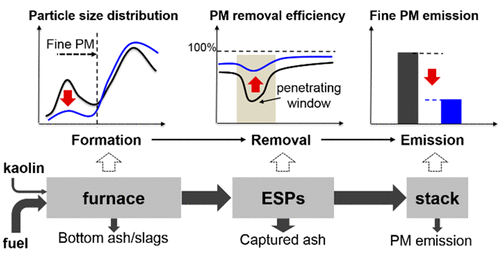当前位置:
X-MOL 学术
›
Environ. Sci. Technol.
›
论文详情
Our official English website, www.x-mol.net, welcomes your
feedback! (Note: you will need to create a separate account there.)
Influences of In-Furnace Kaolin Addition on the Formation and Emission Characteristics of PM2.5 in a 1000 MW Coal-Fired Power Station
Environmental Science & Technology ( IF 10.8 ) Pub Date : 2018-07-16 , DOI: 10.1021/acs.est.8b02251 Yishu Xu 1 , Xiaowei Liu 1 , Hao Wang 1 , Xianpeng Zeng 1 , Yufeng Zhang 1 , Jinke Han 1 , Minghou Xu 1 , Siwei Pan 2
Environmental Science & Technology ( IF 10.8 ) Pub Date : 2018-07-16 , DOI: 10.1021/acs.est.8b02251 Yishu Xu 1 , Xiaowei Liu 1 , Hao Wang 1 , Xianpeng Zeng 1 , Yufeng Zhang 1 , Jinke Han 1 , Minghou Xu 1 , Siwei Pan 2
Affiliation

|
The impacts of in-furnace kaolin addition on the formation and emission characteristics of PM2.5 from a 1000 MW coal-fired utility boiler equipped with electrostatic precipitators (ESPs) are investigated for the first time ever in this contribution. Detailed characterization of the chemical composition, micromorphology, melting characteristics of the fine PM, total fly ash, and/or bottom ash samples were carried out using the X-ray fluorescence probe, the field emission scanning electron microscope coupled with an energy dispersive X-ray detector, the ash fusion analyzer, and the dust specific resistivity analyzer. The results showed that the formation of fine PM was reduced when kaolin was added, and the mass concentrations of the particulate matter with the aerodynamic diameters of ≤0.3 and 2.5 μm (PM0.3 and PM2.5) were reduced by 55.97% and 5.48%, respectively. As expected, kaolin reacted with the volatile mineral vapors (e.g., Ca, Na) and inhibited their partitioning into ultrafine PM. It was interesting to find that the added kaolin modified the ash melting behavior, and promoted the capture of the ultrafine PM onto the coarse particles. What is more, the added kaolin reduced the specific resistivity of the fly ash and improved their capture efficiency in the ESPs. Finally, the above combined effects brought about the emission reductions of 41.27% and 36.72% for PM0.3 and PM2.5 after the ESPs. These results provided a direct confirmation on the feasibility of in-furnace kaolin addition on the PM reduction in the realistic combustion conditions.
中文翻译:

炉内高岭土的添加对1000 MW燃煤电厂PM 2.5形成和排放特性的影响
在这一贡献中,首次研究了炉内高岭土对装有静电除尘器(ESP)的1000 MW燃煤电站锅炉PM 2.5的形成和排放特性的影响。使用X射线荧光探针,场发射扫描电子显微镜和能量色散X-射线探针对精细PM,总粉煤灰和/或底灰样品的化学组成,微观形态,熔融特性进行了详细表征射线探测器,灰熔融分析仪和粉尘比电阻分析仪。结果表明,添加高岭土可减少细颗粒PM的形成,且空气动力学直径≤0.3和2.5μm的颗粒物的质量浓度(PM0.3和PM 2.5)分别降低了55.97%和5.48%。不出所料,高岭土与挥发性矿物蒸汽(例如,Ca,Na)发生反应,并抑制了其分配为超细PM。有趣的是,添加的高岭土改变了粉煤灰的熔融行为,并促进了将超细颗粒PM捕集到粗颗粒上。而且,添加的高岭土降低了粉煤灰的比电阻,并提高了它们在电除尘器中的捕集效率。最后,上述综合效应使PM 0.3和PM 2.5的排放量减少了41.27%和36.72%。在ESP之后。这些结果直接证实了在现实的燃烧条件下添加炉内高岭土对减少PM的可行性。
更新日期:2018-07-18
中文翻译:

炉内高岭土的添加对1000 MW燃煤电厂PM 2.5形成和排放特性的影响
在这一贡献中,首次研究了炉内高岭土对装有静电除尘器(ESP)的1000 MW燃煤电站锅炉PM 2.5的形成和排放特性的影响。使用X射线荧光探针,场发射扫描电子显微镜和能量色散X-射线探针对精细PM,总粉煤灰和/或底灰样品的化学组成,微观形态,熔融特性进行了详细表征射线探测器,灰熔融分析仪和粉尘比电阻分析仪。结果表明,添加高岭土可减少细颗粒PM的形成,且空气动力学直径≤0.3和2.5μm的颗粒物的质量浓度(PM0.3和PM 2.5)分别降低了55.97%和5.48%。不出所料,高岭土与挥发性矿物蒸汽(例如,Ca,Na)发生反应,并抑制了其分配为超细PM。有趣的是,添加的高岭土改变了粉煤灰的熔融行为,并促进了将超细颗粒PM捕集到粗颗粒上。而且,添加的高岭土降低了粉煤灰的比电阻,并提高了它们在电除尘器中的捕集效率。最后,上述综合效应使PM 0.3和PM 2.5的排放量减少了41.27%和36.72%。在ESP之后。这些结果直接证实了在现实的燃烧条件下添加炉内高岭土对减少PM的可行性。











































 京公网安备 11010802027423号
京公网安备 11010802027423号